
A History of and Guide to
UNIFORM EDITIONS OF MARK TWAIN'S WORKS
"They may finish supplying Vol. 23 to old subscribers
to the Uniform editions. (Necessarily they must do this, whether they pay
me anything on it or not.)"
- Samuel Clemens to Henry H. Rogers, 25 June 1903
Chapter 25
Brief Overview of Volume 23:
My Début as a Literary Person and Other Essays and Stories (1903)
Retitled
The Man That Corrupted Hadleyburg and Other Essays and Stories (1904)
Compiling Volume 23
My Début as a Literary Person and Other Essays and
Stories, Volume 23, is the last volume of American Publishing
Company's uniform edition that Frank Bliss would publish. It had been three
years since he had published Volume 22 and it was up to individual subscribers
to continue to purchase new volumes to add to the sets they acquired in
1899. In 1900, at the time Frank Bliss was compiling How to Tell a Story
and Other Essays, Volume 22, Harper and Brothers had been at work compiling
a collection of stories and essays titled The Man That Corrupted Hadleyburg
and Other Stories and Essays for publication in their uniform
red cloth and gold cornstalk binding. Bliss's Volume 22 was copyrighted
on April 9, 1900. Harper copyrighted their book a few weeks later on April
30, 1900. "The Man that Corrupted Hadleyburg" was the lead story
for Harper's collection of previously published essays. Bliss's Volume 22
and Harper's The Man That Corrupted Hadleyburg and Other Stories and
Essays contained a number of stories in common. The following chart
compares the two tables of contents.
Titles in bold designate the stories in common between
the two volumes.
|
ORIGINAL FIRST EDITION
|
Table of Contents for Vol. 22
American Publishing Company 1900 Uniform Editions and Harper's editions
through mid-1917
|
|
The Man That Corrupted Hadleyburg and Other
Stories and Essays
(Harper and Brothers, 1900)
- The Man That Corrupted Hadleyburg
- My Début as a Literary Person
- From the "London Times" of 1904
- At the Appetite-Cure
- My First Lie, and How I Got Out of It
- Is He Living or Is He Dead?
- The Esquimau Maiden's Romance
- How to Tell a Story
- About Play-Acting
- Concerning the Jews
- Stirring Times in Austria
- The Austrian Edison Keeping School Again
- Travelling with a Reformer
- Private History of the "Jumping Frog" Story
- My Boyhood Dreams
|
How to Tell a Story and Other Essays on
title page with
Literary Essays on spine
- How to Tell a Story
- In Defence of Harriet Shelley
- Fenimore Cooper's Literary Offences
- Travelling with a Reformer
-
Private History of the "Jumping Frog
Story"
-
Mental Telegraphy Again
-
What Paul Bourget Thinks of Us
-
A Little Note to M. Paul Bourget
- The Invalid's Story
- The Captain's Story
- Stirring Times in Austria
- Concerning the Jews
- From the "London Times" of 1904
- At the Appetite Cure
- In Memoriam
- Mark Twain: A Biographical Sketch
|
What is evident from comparing the above charts is that in 1900 Harper's
volumes offered additional stories that Bliss's Volume 22 did not feature.
To that end, Bliss was compiling the contents for Volume 23 as early as
August 1902 and it would be deposited for copyright in Washington, D. C.
on April 28, 1903. Bliss chose to make "My Début as a Literary
Person" the lead story of Volume 23. It was an essay that had appeared
in Century magazine in November 1899. Harper had included the essay
in the 1900 first edition of The Man That Corrupted Hadleyburg and Other
Stories and Essays but did not consider it a story worthy of top billing.
"My Début as a Literary Person" was Clemens's memoir of the
time he had written about the sinking of the Hornet in 1866 and the survival
of fifteen men who spent 46 days in an open lifeboat. Clemens had made use of
diaries kept by Reverend Henry Ferguson and his brother Samuel when he first
wrote the news story. After reading Clemens's story in the Century in
November 1899, Reverend Ferguson, then a professor at Trinity College in Hartford,
wrote Clemens objecting to the use of proper names from his diary in uncomplimentary
passages related to the lifeboat survivors. As a sort of apology to Reverend
Ferguson, Clemens donated the proceeds from the Century article to a
church in Ferguson's hometown. Clemens agreed to remove the proper names and
replace them with asterisks when the story was included in Harper's 1900 edition
of The Man That Corrupted Hadleyburg and Other Stories and Essays. Bliss
followed Harper's lead and did not publish the proper names from Ferguson's
diary. Thus, the Century article of November 1899 was the only original
text of "My Début as a Literary Person" until the editors of
the Mark Twain Papers provided an authoritative text of the essay in Autobiography
of Mark Twain (University of California Press, 2010) based on Clemens's
original manuscript and the Century printing.
In Volume 23 Bliss included eight other magazine stories that Harper had used
in the 1900 edition of The Man That Corrupted Hadleyburg and Other Stories
and Essays. These included: "Is He Living or Is He Dead?" from
Cosmopolitan, September 1893; "The Esquimau Maiden's Romance,"
from Cosmopolitan, November 1893; "The Austrian Edison Keeping School
Again" from Century, August 1898; "About Play Acting,"
from Forum, October 1898; "The Man That Corrupted Hadleyburg,"
from Harper's Magazine, December 1899; "My First Lie and How I Got
Out of It," from New York World, December 10, 1899; and "My
Boyhood Dreams," from McClure's, January 1900.
Bliss added six additional items to Volume 23 that had not been included in
previous Harper volumes, in effect putting his uniform edition collection a
step ahead of the Harper's editions at that time. These include "Extracts
from Adam's Diary" which had first been published in 1893 by Underhill
and Nichols in the Niagara
Book, a souvenir publication for the Buffalo, New York World's Fair.
Additional stories include "Diplomatic Pay and Clothes," from Forum,
March 1899; "Two Little Tales," from Century, November 1901;
"The Death Disk" from Harper's Monthly, December 1901 and "A
Double-Barrelled Detective Story," from Harper's Monthly of January
and February 1902. At Clemens's urging, Harper also granted Bliss permission
to use "The Belated Russian Passport" from Harper's Weekly of
December 6, 1902. It is the first collected appearance for that story. With
the compilation of Volume 23, Frank Bliss had managed to include all of the
stories that Harper and Brothers had included in their previous uniform editions
of red cloth and gold cornstalks, plus add a few not previously collected in
book form in the United States. The following chart compares the table of contents
for Volume 23 to the 1900 edition of The Man That Corrupted Hadleyburg and
Other Stories and Essays.
Titles in bold are unique to Volume 23.
|
ORIGINAL FIRST EDITION
|
Table of Contents for Vol. 23
American Publishing Company 1903 Uniform Editions
|
|
The Man That Corrupted Hadleyburg and Other Stories
and Essays
(Harper and Brothers, 1900)
- The Man That Corrupted Hadleyburg
- My Début as a Literary Person
- From the "London Times" of 1904 (used in Vol. 22)
- At the Appetite-Cure (used in Vol. 22)
- My First Lie, and How I Got Out of It
- Is He Living or Is He Dead?
- The Esquimau Maiden's Romance
- How to Tell a Story (used in Vol. 22)
- About Play-Acting
- Concerning the Jews (used in Vol. 22)
- Stirring Times in Austria (used in Vol. 22)
- The Austrian Edison Keeping School Again
- Travelling with a Reformer (used in Vol. 22)
- Private History of the "Jumping Frog" Story (used in Vol.
22)
- My Boyhood Dreams
|
My Début as a Literary Person on
title page with My Literary Début on spine
_____
* First collected appearance
** First American collected appearance
|
Refining the Work
Although Clemens had an opportunity to revise and refine his
work for Volume 23 of the uniform edition, there is little evidence to suggest
he took an active interest in doing so. However, no extensive comparison
between Volume 23 and the previous printings of each essay has been conducted.
Bliss did revise the spelling on "A Double-Barrelled Detective Story"
choosing to use the spelling "Barreled."
For the first 22 volumes of American Publishing Company's
uniform editions published from 1899-1900, Frank Bliss hired Forrest Morgan
to proofread for errors. There is no evidence that Morgan had an opportunity
to proofread Volume 23 in 1903.
Different Title on the Spine
Instead of using the book's title My Début as a
Literary Person and Other Essays and Stories on the spine of
Volume 23, Bliss chose to identify the book as Volume XXIII / My Literary
Début. This designation appears on all the editions published
by American Publishing Company including Autograph
Edition, Edition De Luxe,
Japan Edition, Author's
De Luxe Edition, Royal
Edition, Underwood Edition, Riverdale
Edition and American Publishing Company's Hillcrest
Edition of 1903.
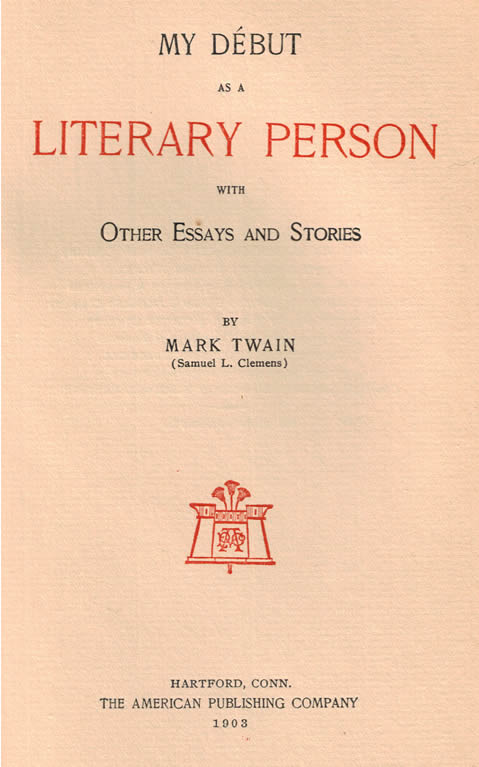
Secondary
title page for Volume 23 reads
My Début as a Literary Person and Other Essays and
Stories |

Spine
for Volume 23 reads My Literary Début |
W. H. W. Bicknell's Contributions
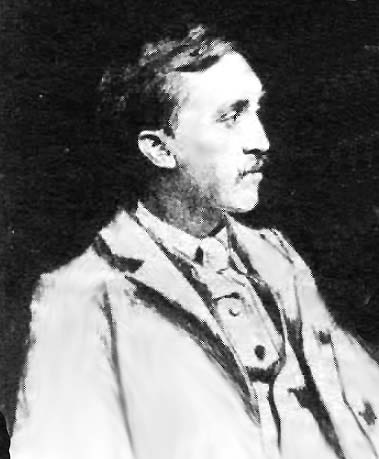
William
Harry Warren Bicknell
photo courtesy of the Winchester, Massachusetts Archival Center |
Frank Bliss hired new illustrators for the uniform edition. Artist
and etcher William Harry Warren Bicknell (b. 1860 - d. 1947) was born
in Boston, Massachusetts, the son of a grocer. Bicknell graduated
from the Boston Latin School in 1878 and later studied at the Boston
Museum of Fine Arts. He was a pupil of Otto Grundmann and Frederic
Crowningshield. Bicknell etched a number of frontispieces made from
photographs of Clemens that were used throughout the set. Bicknell's
etching of the Tiffany monogram appears as a title page in every volume
of the Autograph Edition,
Edition De Luxe, Japan
Edition, Author's
De Luxe Edition, and the Royal
Edition. Bicknell's engraved title page is present in Volume 23
but it is omitted from the illustration list. Thus, Bicknell's work
is uncredited in Volume 23.
In order to reduce production costs the Underwood,
Riverdale, and
Hillcrest editions featured the
Tiffany title page only in Volume 1. The Author's
National Editions eliminated the Tiffany title page altogether.
These later editions also eliminated a number of Bicknell's engraved
frontispieces.
|
Frontispiece
The frontispiece for Volume 23 is an uncredited photo of
Clemens dated 1902.
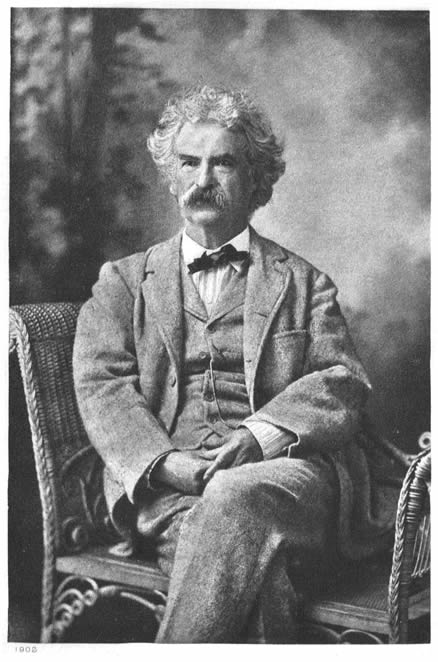
Francis Luis Mora, Illustrator
Frank Bliss did not use the original illustrations that had
appeared with the magazine publication of a number of the stories included
in Volume 23. Both "The Death Disk" and "Double Barreled
Detective Story" had been illustrated by Lucius Wolcott Hitchcock in
Harper's Magazine. "Two Little Tales" was illustrated by
Frederick Dorr Steele for Century magazine. Instead of reusing the
magazine illustrations, Bliss hired Francis Luis Mora to draw three new
illustrations for Volume 23.
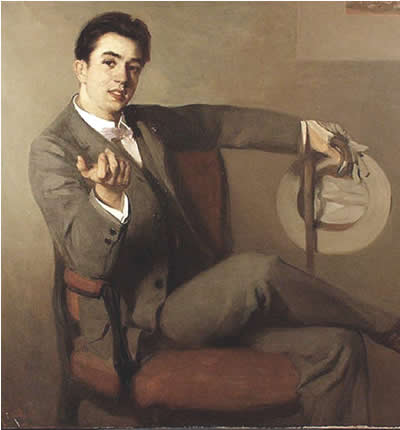
Portrait
of Francis Luis Mora
by James Allen St. John |
Francis Luis Mora (b.1874 - d. 1940) was born in Montevideo, Uruguay.
His father Domingo Mora was a Spanish sculptor. His mother Laura Gillard
was born in France. The family left Uruguay in 1877 and in the 1880s
settled in New Jersey. Mora attended school at Manning's Seminary
in Perth Amboy, New Jersey as well as public schools in New York and
Boston. He studied art at the School of Drawing and Painting at the
Museum of Fine Arts in Boston where he studied under Edmond Tarbell
and Frank Benson. He also studied at the Art Students League in New
York under Henry Siddons Mowbray. Mora likely studied alongside artist
James Allen St. John who illustrated Volume
21 of Mark Twain's uniform edition. A November 1898 interview
in Metropolitan magazine identifed St. John's portrait of Mora
as one of his best.
|
| Beginning about 1892 Mora worked as an
illustrator for magazines and periodicals including Harper's Weekly,
Scribner's, Century, Collier's, Sunday Magazine,
and Ladies' Home Journal. His first important commission was
for a large decorative panel for the Lynn, Massachusetts Public Library
which he completed in 1900.
On August 18, 1902 Frank Bliss paid Mora $300 for three full-page
black and white drawings for Volume 23. The receipt for those illustrations
survives in archives at the University
of Virginia Library, Special Collections,
Mora later worked as a teacher at the New York School of Art. Among
his students was Georgia O'Keeffe, who studied with him between 1907
and 1908.
|
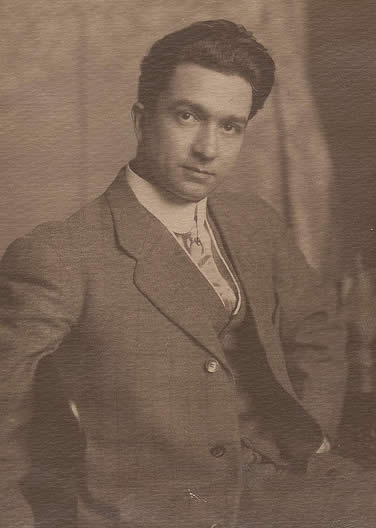
Francis Luis Mora |
Mora's full-page illustrations for Volume 23 were for "The Esquimau
Maiden's Romance," "Two Little Tales," and "A Double-Barreled
Detective Story." "The Esquimau Maiden's Romance" was initally
published in Cosmopolitan, November 1893, with illustrations by Daniel
Carter Beard. Mora's illustration for that story is for the same scene Beard
illustrated.
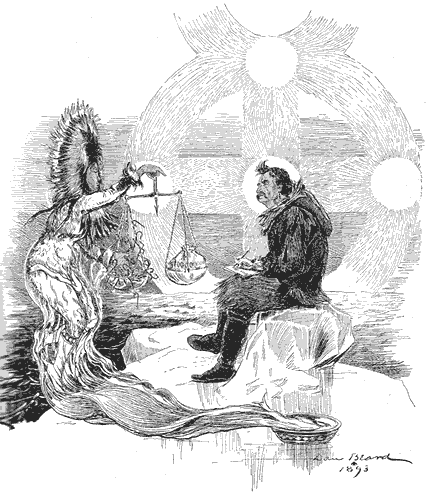
Illustration
by Daniel Carter Beard for "Esquimau Maiden's Romance" in
Cosmopolitan, November 1893 |
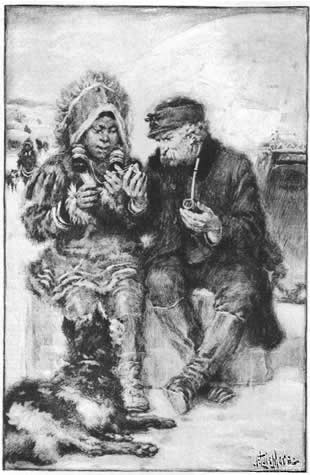
"Listening
to Her Story" by Francis Luis Mora for "Esquimau Maiden's
Romance" in Volume 23, My Début as a Literary Person
and Other Essays and Stories (American Publishing Company, 1903) |
-
- LISTENING TO HER STORY - (Francis Luis Mora)
-
JIMMY SAVES THE EMPEROR - (Francis Luis Mora)
- STILLMAN ACCUSES SHERLOCK HOLMES - (Francis Luis Mora)
Harper and Brothers Revises the Title and Contents
In October 1903 Harper and Brothers bought out American Publishing
Company including the unsold inventory of Frank Bliss's 1903 Hillcrest
Edition. Over a year later on December 10, 1904 The New York Times
reported that Harper and Brothers would be releasing a new Hillcrest Edition
from new printing plates. In 1904, Volume 23 of the Harper Hillcrest Edition
was retitled The Man That Corrupted Hadleyburg and Other Essays and Stories.
This title appeared on both the title page and spine of the new edition.
Harper believed "The Man That Corrupted Hadleyburg" was the most
powerful story in the collection.
From 1903 until 1916 the contents of Volume 23 remained
the same. In 1917 Harper revised the contents of The Man That Corrupted
Hadleyburg and Other Essays and Stories for a new printing of the Author's
National Edition. This reshuffling of material is one source of confusion
for book collectors who often try to acquire replacement volumes for incomplete
sets. The task is further complicated due to the fact that the bindings
for a number of years were extremely similar even though the contents were
different.

Harper
edition of Vol. 23, The Man That Corrupted Hadleyburg and Other Essays
and Stories with printing date of L-Q (November 1916) retains the
original 1903 table of contents. |

Harper
edition of Vol. 23, The Man That Corrupted Hadleyburg and Other Essays
and Stories with printing date of G-T (July 1919) features slightly
smaller binding and Arabic volume numbers 23 on the spine and different
contents. |
For the 1917 Author's National Edition, Harper and Brothers removed "Extracts
from Adam's Diary" from Volume 23 and added "The £1,000,000
Bank-Note" and "A Petition to the Queen of England." The
additions were stories that had previously been part of Volume 21, The
American Claimant and Other Stories and Sketches.
The following table details the shifting contents of
Volume 23.
Titles in bold are unique to each volume.
|
The Man That Corrupted Hadleyburg and Other
Essays and Stories
Volume 23
(1904 - mid-1917)
|
The Man That Corrupted Hadleyburg and Other
Essays and Stories
Volume 23
(mid-1917)
|
-
The Man That Corrupted Hadleyburg
-
My Début as a Literary Person
- The Esquimau Maiden's Romance
- My First Lie, and How I Got Out of It
-
The Belated Russian Passport
-
Two Little Tales
-
About Play-Acting
-
Diplomatic Pay and Clothes
- Is He Living or Is He Dead?
- My Boyhood Dreams
- The Austrian Edison Keeping School Again
- Extracts from Adam's Diary
- The Death Disk
- A Double-Barreled Detective Story
|
-
The Man That Corrupted Hadleyburg
-
My Début as a Literary Person
- The £1,000,000 Bank-Note (moved from pre-1917
Vol. 21)
- The Esquimau Maiden's Romance
- My First Lie, and How I Got Out of It
-
The Belated Russian Passport
-
Two Little Tales
-
About Play-Acting
-
Diplomatic Pay and Clothes
- Is He Living or Is He Dead?
- My Boyhood Dreams
- The Austrian Edison Keeping School Again
- The Death Disk
- A Double-Barreled Detective Story
- A Petition to the Queen of England (moved from pre-1917 Vol.
21)
|
_____
References
Blanck,
Jacob, compiler. Bibliography of American Literature, Volume Two. (Yale
University Press, 1957).
Estes,
Arthur B. "J. Allen St. John," Metropolitan Magazine, 1898
November, pp. 503-06.
"F.
Luis Mora, 65, A Noted Painter," The New York Times, 6 January
1940, p. 25.
Johnson,
Merle. A Bibliography of the Works of Mark Twain. (Harper and Brothers,
1935).
Leary,
Lewis, ed. Mark Twain's Correspondence with Henry Huttleston Rogers 1893-1909.
(University of California Press, 1969).
"Luis
Mora at Home, A Prophet Honored," The New York Times, 11 September
1927, p. X11.
Mora,
F. Luis to American Publishing Company, 18 August 1902. Accession No. 6314,
Box 8. (University
of Virginia Library, Special Collections).
Rasmussen,
R. Kent. Critical
Companion to Mark Twain, Volumes I and II. (Facts on File, 2007).
Twain,
Mark. Autobiography of Mark Twain. Edited by Harriet Elinor Smith,
et. al. (University of California Press, 2010).
_____.
The Man That Corrupted Hadleyburg and Other Stories and Essays. (Oxford
University Press, 1996).
_____.
My Début as a Literary Person and Other Essays and Stories.
Royal Edition. (American Publishing Company, 1903).












